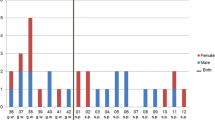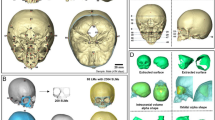Abstract
Temporal bone histological findings can be evaluated from several points of view. The most basic consists of a description of the characteristics and abnormalities of particular temporal bones. The second one is the measurement of various structures in a larger set of temporal bones and the monitoring of these structures over time. The height of stapes was measured in a set of 40 temporal bones from 27 fetuses, and the growth of stapes from the 13th to 36th weeks of pregnancy was determined. A computer-assisted nonlinear regression analysis of diagnostics enabling simultaneous examination of data (influential points, i.e., outliers and leverages) was carried out, a growth curve model proposed and a mathematical method with Ratkowski criteria for estimation applied to find the best descriptive model of the height of stapes versus time y=f(x) growth curve; the results of 13 growth models were examined. It was found that the maximum growth of the height of stapes was between the 13th and the 24th weeks of pregnancy. The average height of stapes was 1.05 mm in the 13th week and 2.6 mm in the 24th week. Later, after the 25th week, the growth of the height of stapes was slower, and the average height in the 30th week was 3.0 mm.



Similar content being viewed by others
References
Adstat 2.0 Statistical package, Pardubice: TriloByte Statistical Software, 1999
Anson BJ, Donaldson JA (1992) Surgical anatomy of the temporal bone, part 2. Raven Press, New York, pp 26–30
Bardsley WG, Ackerman RA, Bukhari NAS, Deming DC, Ferguson MWJ (1995) Mathematical models for growth in alligator embryos developing at different incubation temperatures. J Anat 187: 181–190
Bock RD, Thissen D (1976) Fitting multi-component models for growth in stature. Proceedings of the 9th international biometric conference 1: 431–442
Clutter JL, Fortson JC, Pienaar LV, Brister GH, Bailey RL (1983) Timber management: a quantitative approach. Wiley, New York, p 333
Dalgaard P, Koutsoumanis K (2001) Comparison of maximum specific growth rates and lag times estimated from absorbance and viable count data by different mathematical models. J Microbiol Meth 43: 183–196
Elfving B, Kiviste A (1997) Construction of site index equations for Pinus sylvestris L. using permanent plot data in Sweden. Forest Ecol Manag 98: 125–134
Gamito S (1998) Growth models and their use in ecological modelling. Ecolog Modelling 113: 83–94
Gompertz B, Philos T (1825) Roy Soc London 115: 513
Jolicoeur P, Pontier J, Pernin MO, Sempé M (1988) A lifetime asymptotic growth curve for human height. Biometrics 44: 995–1003
Kuzmitschev VV (1977) Stand growth regularities (in Russian). Novosibirsk, p 160
Lebert I, Robles-Olvera V, Lebert A (2000) Application of polynomial models to predict growth of mixed cultures of Pseudomonas spp. and Listeria in meat. Int J Food Microbiol 61: 27–39
Ledford AW, Cole TJ (1998) Mathematical models of growth in stature throughout childhood. Ann Hum Biol 25: 101–115
Meloun M, Militký J, Forina M (1992) Chemometrics for analytical chemistry, vol 1, PC-Aided statistical data analysis. Ellis Horwood, Chichester
Meloun M, Militký J (1996) Sbírka úloh, Statistické zpracování experimentálních dat. Pardubice: Universita Pardubice
Mitscherlich EA (1919) Das Gesetz des Pflanzenwachstums. Landwirtsch Jahrb 53: 167–182
Nandapalan V, Tos M (2000) Isolated congenital stapes ankylosis: an embryologic survey and literature review. Am J Otol 21: 71–80
Pauw BKH, Pollak AM, Fisch U (1991) Utricule, saccule, and cochlear duct in relation to stapedotomy. Ann Otol Rhinol Laryngol 100: 966–970
Peschel W (1938) Die mathematische Methoden zur Herleitung der Wachstumsgesetze von Baum and bestand und die Ergebnisse ihrer Anwendung. Tharandter Forstl Jahrb 89: 169–247
Preece MA, Baines MJ (1978) A new family of mathematical models describing the human growth curve. Ann Hum Biol 5: 1–24
Prodan M (1968) Forest biometrics. London, p 447
Ratkowski DA (1983) Nonlinear regression modeling: a unified practical approach. Marcel Dekker, New York
Ratkowski DA (1993) Principles of nonlinear regression modeling. J Ind Microbiol 12: 195–199
Reynolds K (1995) Forest height growth modelling. Forest Ecol Manag 71: 217–255
Richards FJ (1959) A flexible growth function for empirical use. J Exp Bot 10: 290–300
Schepers AW, Thibault J, Lacroix C (2000) Comparison of simple neural networks and nonlinear regression models for descriptive modeling of Lactobacillus helveticus growth in pH-controlled batch cultures. Enzyme Microb Tech 26: 431–445
Schnute J (1981) A versatile growth model with statistically stable parameters. Can J Fish Aquat Sci 38: 1128–1140
Schuknecht HF (1993) Pathology of the ear. Lea and Febiger, Malvern, p 33
Shohoji T, Sasaki H (1979) Individual growth of Japanese. Growth 51: 432–450
Suslick SB, Harris DP, Allan LHE (1995) SERFIT: an algorithm to forecast mineral trends. Computers Geosci 21: 703–713
Todorovic D (1961) Tree growth laws and their mathematical equations. Thesis, Belgrad, p 206
Weber R (1897) Heber die Gesetzmässigkeit im Zuwachsgange einiger Holzarten, auf Grund neuerer Ertragstefeln. Allg Forst U Jagdztg: 185–196
Wenk G (1973) Mathematische Formulierung von Wachsturmsprozessen. Biom Z 15: 345–362
Acknowledgements
This paper was supported by a research grant from the Ministry of Health of the Czech Republic, grant no. IGA MZ 6189-3 and by the Grant Agency of the Czech Republic, grant no. 303/00/1559.
Author information
Authors and Affiliations
Corresponding author
Rights and permissions
About this article
Cite this article
Chrobok, V., Meloun, M. & Šimáková, E. Descriptive growth model of the height of stapes in the fetus: a histopathological study of the temporal bone. Eur Arch Otorhinolaryngol 261, 25–29 (2004). https://doi.org/10.1007/s00405-003-0580-4
Received:
Accepted:
Published:
Issue Date:
DOI: https://doi.org/10.1007/s00405-003-0580-4




